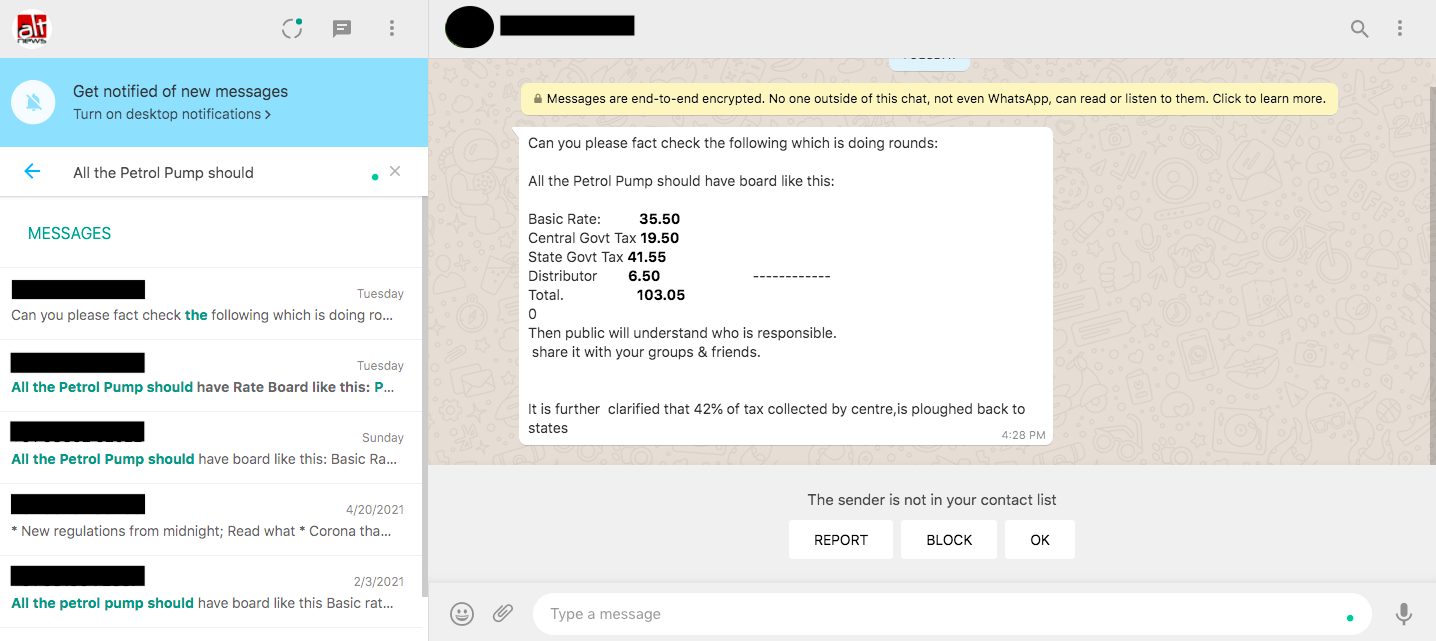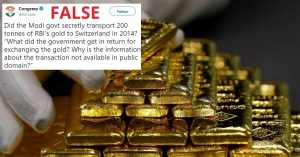Several social media users have shared a purported break-up of fuel prices that claims state governments levy twice as much tax on petrol as the central government. Multiple Twitter users have posted this claim including @raghu4bjp. This is viral amid rising fuel prices and the central government being criticised for the price crossing even the Rs 100 mark in several states.

The claim is also widespread on Facebook.
[Viral text: All Petrol Pump should have a board like this: Basic rate 35.50 Central government 19.50 State Government 41.55 Dealers 6.50 Total 103.05 Then public will understand who is responsible share it with your groups and friends.]

Alt News has received multiple verification requests for the message on our WhatsApp helpline number (76000 11160) and our mobile application. Download our mobile application to send such forwards for verification. (Android, iOS)

Alt News noticed that a similar claim was made in 2017 by Twitter user @1_kewal.

FACT-CHECK
It was recently reported that India is the world’s third-largest crude oil importer. The country imports 84% of its oil requirements. Fuel prices change each month or even every day in India due to external factors like global crude oil prices. But internal factors like taxes and dealers’ commissions also impact the price of domestic petrol.
Petroleum Planning & Analysis Cell (PPAC) has responded to the question, “How are prices of major petroleum products i.e. Petrol, Diesel, PDS Kerosene and Domestic LPG are decided?” in the FAQ section. As per PPAC, fuel prices are decided by the Public Sector Oil Marketing Companies (OMCs) namely, Indian Oil Corporation Limited, Hindustan Petroleum Corporation Limited and Bharat Petroleum Corporation Limited, in line with the changes in the international market prices and other market conditions.
According to ICRA Limited, an Indian government credit rating agency, the cess on unbranded petrol remains unchanged at ₹32.9/litre in FY21. This is also called excise duty which is collected by the central government. Alt News spoke with Prashant Vasisht, vice-president and co-group head at ICRA. He said, “The excise duty was last changed in May 2020 by the central government. Unlike international fuel prices, this doesn’t change daily. It is fixed by the central government.”
The tax on fuel does not fall under the Goods and Services Tax (GST). Thus fuel prices in India vary from state to state and even city to city. The latest retail fuel prices in metro cities are listed on PPAC’s website. For the ease of explaining the price break-up, this article analyses the fuel prices in the national capital as of July 1 according to Bharat Petroleum (BP). The report is split into the following sections:
- What is the tax rate at the state level?
- Understanding the price build-up of fuel at Bharat Petroleum in Delhi
- Understanding tax rates at state and centre level
- Tax per litre of petrol in states with the highest tax in July 2021
What is the tax rate at the state level?
The latest state-wise taxes are listed on the website of PPAC under the ‘Sales Tax‘ sub-section. Taxes in most states range between 20-25%. The highest rate of tax on fuel is in Manipur (36.50% VAT), followed by Rajasthan (36% VAT+ ₹1500/KL road development cess) and Karnataka (35% sales tax). The lowest tax rate is in Andaman & Nicobar Islands at 6%. No other state charges sales tax or VAT in single digit.
The following data shows the statewise rate of tax on petrol, as per PPAC.
Understanding the price build-up of fuel at Bharat Petroleum in Delhi
Bharat Petroleum gives the following price build-up of petrol at Delhi as of July 1.

- Price Charged to Dealers (excluding Excise Duty and VAT): This is the price OMCs charge the dealer. Vasisht explained, “The price charged to dealers (as mentioned in the price buildup of auto fuels) is based on the trade parity price (TPP) and includes a freight component. The TPP is calculated as 80% of import parity price plus 20% of export parity price.” As per PPAC, Import Parity Price (IPP) represents the price that importers would pay in case of actual import of product at the respective Indian ports. This includes FOB price, ocean freight, insurance, customs duty, port dues, etc. While the Export Parity Price represents the price oil companies would realise on the export of petroleum products. This includes FOB price and advance license benefit (for duty-free import of crude oil pursuant to the export of refined products).
- Excise Duty: This is the cess charged by the central government and it is consistent across the country. As of July 1, excise duty is ₹32.90 per litre.
- Dealer Commission: According to Livemint, the dealer commission is different for petrol and diesel and varies from the location of fuel pumps, ranging from ₹2-4/litre. “This amount goes to the petrol pump owners,” said Vasisht. Alt News spoke to a petrol pump owner in Delhi who confirmed the same and added, “This is the source of revenue for petrol pump owners. It covers our operating costs such as salaries, water, electricity bill, etc.”
- VAT: This is the cess charged by the state. In Delhi, this stands at ₹22.81 or 30% as per PPAC and BPCL. The tax is levied on the sum of the previous three components (price charged to dealers, excise duty and dealer commission) i.e., 30% of ₹76.04 = ₹22.81.
Understanding tax rates at state and centre levels
Studying excise duty and VAT in Delhi makes it clear that the Delhi government doesn’t charge more tax on fuel than the central government.
The VAT in Delhi is 30% of ₹76.04 = ₹22.81. We calculated the share of excise duty (prior to VAT) in Delhi (32.90/76.04×100) and it comes to 43.27%.
As pointed earlier, the highest VAT is 36.50% in Manipur. Thus, no state government charges more tax than the central government.
Earlier, Alt News had recently published a report debunking the false claim that states levy 55% tax on domestic LPG against the centre’s 5%. Domestic LPG is taxed under 5% GST divided equally between the state and centre.
Independent journalism that speaks truth to power and is free of corporate and political control is possible only when people start contributing towards the same. Please consider donating towards this endeavour to fight fake news and misinformation.




